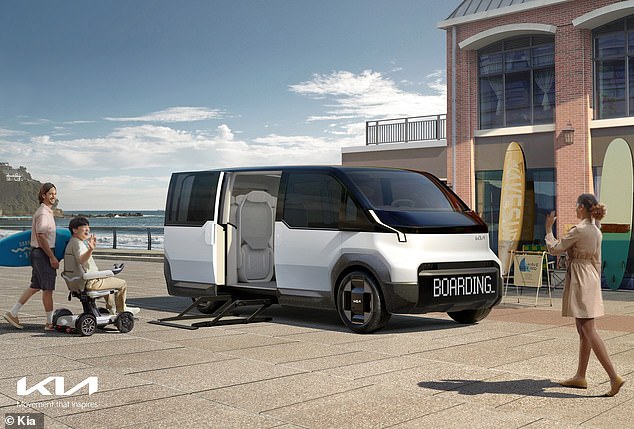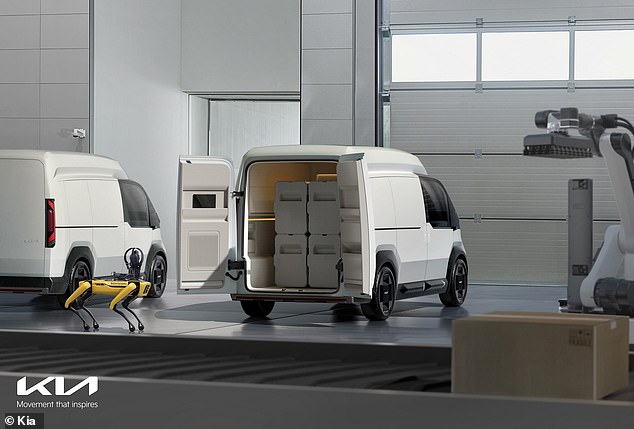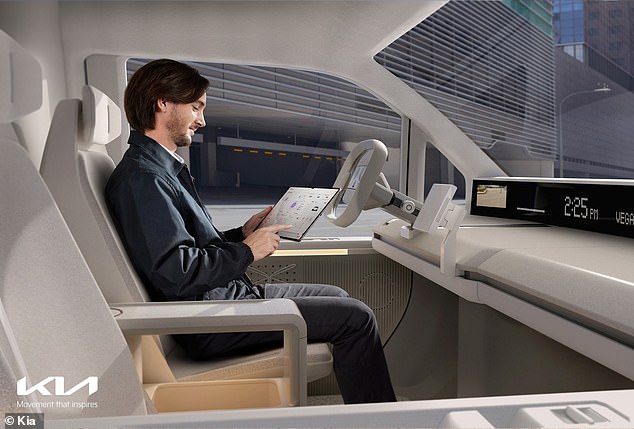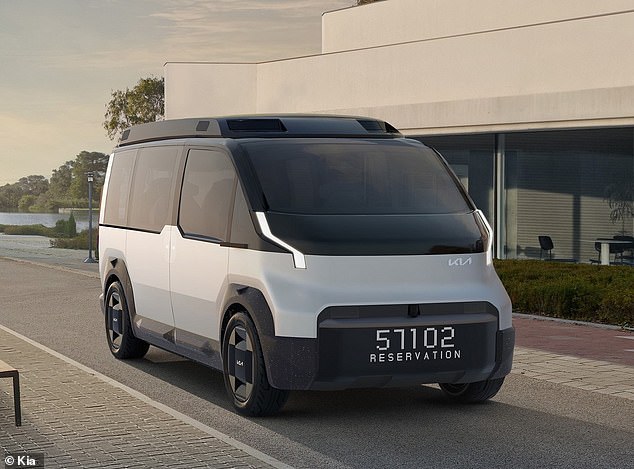Kia PV5 is an electric van that can be converted to a camper for weekends
Not content with achieving huge success in the electric car space with the award-winning EV6 and e-Niro, Kia is entering the electric van market… but with a twist.
The Korean brand unveiled three concept electric commercial vehicles at the Consumer Electronics Show in Vegas this week, the first of which – the PV5 – will arrive in 2026.
All three vans – including the PV1 and PV7 – are based on the Korean brand’s new Purpose Built Vehicle (PVB) system, which Kia says prioritizes ‘extensive modularity’.
This means that they can be used as a company car during the week and converted into a camper for when you want to go away for a weekend.
Kia has unveiled three electric concept cars that use an adaptable Purpose Built Vehicle (PVB) system. The image shows the PV5 (two models shown in the middle) as a commercial vehicle and as an MPV
With the PV5 leading the way as part of Kia’s ‘Beyond Mobility’ strategy, all sequential PV models will feature ‘Easy Swap’ technology to meet different mobility needs.
While the front cab is fixed, the rear is interchangeable.
Various ‘life modules’ that make up the rear or upper body of each vehicle can be switched on and off using mechanical linkage and electromagnetic technology – something a dealer would be responsible to implement.
So the PV5 can be a van for a week and then serve as a passenger transport when it’s time to carpool children on the weekend. It can even be converted into a camper or taxi.
Kia says it designed the PVB platform for such a level of “enhanced versatility.”

‘Life modules’ allow the rear section of the vehicle to be swapped in and out, turning the PV5 into an MPV, camper or taxi

Kia offers ‘exceptional flexibility and customization through radical modularization’
Initially, Kia is launching the PV5 with a focus on commercial use, with the Basic, Van, High Roof and Chassis Cab versions coming to market first.
Emphasis is placed on simplicity of design with clever twists, although the brand adds that high quality, reliability and capabilities will make PV models suitable for all requirements.
Karim Habib, executive vice president and head of Kia Global Design said: “Kia PBVs will usher in a new era of seamless everyday business and lifestyle solutions.
“We hope to make our customers’ lives easier and better, whether stationary or on the move, by offering exceptional flexibility and customization through radical modularization.”
All PV5 models have large doors that provide access to pillar-less, wide and flat loading areas with integrated rails for maximum versatility.
The cabin even features a desk-like dashboard that can serve as an office on wheels, similar to that of the electric Ford E-Transit Custom.

The PV5 cabin doubles as a mobile office with a dashboard-to-desk design and huge infotainment screens

The multi-way interior is removable and configurable to meet all mobility needs
Futuristic functionality is matched by Sci-Fi looks: sleek, curved one-box bodies with slit-thin LED headlights made from sustainable materials.
By using bioplastic, biopaint, recycled PET material, felt and yarns, Kia aims to ‘provide a unique visual and tactile appeal (…) that reduces the impact on the environment today and tomorrow’.
Tomorrow’s technology is another theme emerging from Kia’s launch.
The PV5 will feature advanced software connectivity as a nod to phases two and three of Kia’s commercial vehicle plans, which include integrated AI and autonomous driving and delivery services.

PV models will feature integrated AI and advanced software connectivity for a personalized experience
Book it as a taxi and it will appear with your name in bold on the front and back. Do you want to enjoy the sun? The transparent roof is also a perovskite solar cell roof that charges the battery en route and supplies electricity directly to the socket next to your seat.
Prices are yet to be confirmed, but Kia is expected to target an entry price of around £30,000.
No details have been released about the PV5’s powertrain either, but it will likely share batteries and motors with Kia’s electric SUVs like the EV6 and EV9. This could bring the predicted range to up to 549 miles (using the EV9’s 95 kWh battery).
The PV7 will go up against Ford’s E-Transit (which has a range of 386 miles) when it’s introduced in 2017 and will come with the option of all-wheel drive.
The PV1, on the other hand, will be designed for flexible urban transport over short distances.
These models complete phase two of Kia’s ‘Beyond Mobility’ strategy.
Phase three will deliver tailor-made mobility solutions to fleets as part of a ‘smart city’ system, with self-driving PV5 Robotaxi equipped with Kia’s Level 4 autonomous driving technology.


